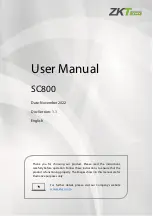
94
When the Lead control mode (R1) determines the output should be activated, R2 turns on because it has the lowest
accumulated on-time. After 2 hours, if the output remains activated, the on-times are re evaluated and R2 turns off
and R1 turns on because it now has the least accumulated total on time. The cycle continues until the Lead control
mode determines the feed is complete.
Time Unbalanced
This wear leveling mode improves fault-tolerance of the group by varying the wear on each pump by activating
each pump for a different percentage of time. In this mode, a primary output is activated most of the time and sec
-
ondary (auxiliary) output(s) are activated for a smaller percentage of the total output on-time. This strategy can be
useful to ensure that a backup pump is exercised sufficiently so that it will be functional when needed, but does not
wear at the same rate as the primary pump to minimize the chances of both pumps failing at the same time. When
one Lag pump is defined within the Lead Lag group, the Lead pump runs 60% of the time and the Lag pump runs
40%. If more than two (2) pumps are defined for the group, fixed ratios are used to insure all pumps are exercised
periodically and wear at different rates, as shown in the chart.
Percent On
Number of Relays
Relay
2
3
4
5
6
1
60.0%
47.4%
41.5%
38.4%
36.5%
2
40.0%
31.6%
27.7%
25.6%
24.4%
3
21.1%
18.5%
17.1%
16.2%
4
12.3%
11.4%
10.8%
5
7.6%
7.2%
6
4.8%
Output Activation Modes
Depending on the current control mode selection for the Lead output, additional settings may be available within
the settings list of the last output in the group to provide additional option(s) to optimize the behavior of the Lead
Lag functionality. Several different activation modes can be selected to control the status of additional output(s)
based on either elapsed time, alternate setpoints, and/or alternate switch inputs.
Disabled
No action is taken to activate more than one output within the Lead Lag group of outputs. This mode is used when
a group of Lead Lag outputs exists only to provide backup in case of a Flow Verify failure on one of the pumps, or
if a pump is taken out of service, and/or if only wear leveling is desired.
Time Based
Lag outputs are activated following the Lead output after a user-settable delay. The same delay value is used for
all outputs. This menu selection is available only when the Lead output is using On/Off, Dual Setpoint, Spike or
Manual control modes.
Example: If the Lead output is set to Manual, this control option could be used to force on the output based on a
digital input signal (e.g., level switch). If the level switch remains open for more than the specified delay time, the
second output in the Lead Lag group is energized. If another delay time elapses, a third output (if available) is also
turned on.
In On/Off, Dual Setpoint, or Spike control modes, additional pump(s) are energized if the process value remains
outside the setpoint range for more than the specified delay time.
Example: In a two-output Lead Lag group (R1←R2), the Lead (R1) output, set for Dual Setpoint control, is pro
-
grammed to energize its output when the D.O. reading is outside the 4.0-4.5 ppb control range with a deadband of
0.1 ppb. Time based output activation is selected with a delay time of 15 minutes. When the D.O. value falls below
4.0 ppb, R1 is activated. After 15 minutes, if the D.O. has not risen to 4.1 ppb or higher, R2 will also be activated.
When the process value reaches 4.1 ppb, both outputs are turned off.
Setpoint Based
Each Lag output has its own setpoint(s) and deadband when this option is selected. The setpoints for each output
















































